
The Laysan duck, also known as the Laysan teal, is a dabbling duck endemic to the Hawaiian Islands. Fossil evidence reveals that Laysan ducks once lived across the entire archipelago, but today survive only on Laysan Island and two atolls. The duck has several physical and behavioral traits linked to the absence of ground-based predators in its habitat. By 1860, the ducks had disappeared from everywhere except Laysan Island. The introduction of European rabbits by guano miners at the end of the 19th century brought the bird to the brink of extinction in 1912, with twelve surviving individuals. Rabbits were eradicated from the island in 1923 and numbers of Laysan ducks began to rise, reaching 500 by the 1950s. In an effort to ensure the long-term future of this duck, 42 birds were translocated to Midway Atoll National Wildlife Refuge in 2002. These thrived in their new surroundings, and another group were later relocated to Kure Atoll.
Located about 2300 miles (3680 km) from the nearest continental shore, the Hawaiian Islands are the most isolated group of islands on the planet. The plant and animal life of the Hawaiian archipelago is the result of early, very infrequent colonizations of arriving species and the slow evolution of those species—in isolation from the rest of the world's flora and fauna—over a period of at least 5 million years. As a consequence, Hawai'i is home to a large number of endemic species. The radiation of species described by Charles Darwin in the Galapagos Islands which was critical to the formulation of his theory of evolution is far exceeded in the more isolated Hawaiian Islands.
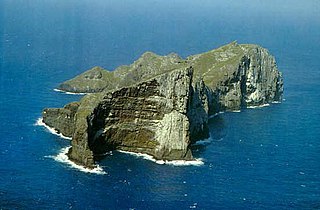
Nihoa, also known as Bird Island or Moku Manu, is the tallest of ten islands and atolls in the uninhabited Northwestern Hawaiian Islands (NWHI). The island is located at the southern end of the NWHI chain, 296 km (160 nmi) southeast of Necker Island. Nihoa is the closest NWHI in proximity to the eight main windward Hawaiian Islands at approximately 240 km (130 nmi) northwest of the island of Kauaʻi. The island has two peaks, 272 m (892 ft) Miller's Peak in the west, and 259 m (850 ft) Tanager Peak in the east. Nihoa's area is about 171 acres (0.69 km2) and is surrounded by a 142,000-acre (57,000 ha) coral reef. Its jagged outline gives the island its name, Nīhoa, which is Hawaiian for "toothed, serrated".

Laysan is one of the Northwestern Hawaiian Islands, located 808 nautical miles northwest of Honolulu. It comprises one land mass of 1,016 acres (4.11 km2), about 1 by 1+1⁄2 miles in size. It is an atoll of sorts, although the land completely surrounds a shallow central lake some 2.4 m (7.9 ft) above sea level that has a salinity approximately three times greater than the ocean. Laysan's Hawaiian name, Kauō, means 'egg'.
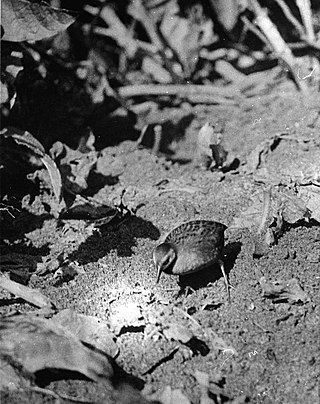
The Laysan rail or Laysan crake was a flightless bird endemic to the Northwest Hawaiian Island of Laysan. This small island was and still is an important seabird colony, and sustained a number of endemic species, including the rail. It became extinct due to habitat loss by domestic rabbits, and ultimately World War II.

The Laysan albatross is a large seabird that ranges across the North Pacific. The Northwestern Hawaiian Islands are home to 99.7% of the population. This small gull-like albatross is the second-most common seabird in the Hawaiian Islands, with an estimated population of 1.18 million birds, and is currently expanding its range to new islands. The Laysan albatross was first described as Diomedea immutabilis by Lionel Walter Rothschild, in 1893, on the basis of a specimen from Laysan Island.

The Nihoa millerbird is a subspecies of the millerbird. It gets its name from its preferred food, the Miller moth. The 5-inch (13 cm) long millerbird has dark, sepia-colored feathers, white belly, and dark beak. Its natural geographic range is limited to the tiny island of Nihoa in the Northwestern Hawaiian Islands, and it is hoped that birds translocated to Laysan will help to ensure the survival of the species. The Nihoa millerbird is one of the two endemic birds remaining on Nihoa, the other being the Nihoa finch.
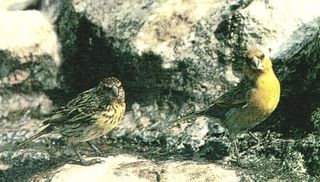
The Nihoa finch is one of the two endemic bird species of the tiny Hawaiian island Nihoa, the other being the Nihoa millerbird. When it was classified in 1917, scientists thought that it would be the last endemic species named. This was later found untrue. The island's population is 1000–3000 birds. The Nihoa finch was added to the Endangered Species List by the U.S. Fish and Wildlife Service on March 11, 1967. An attempt to protect the species against extinction was made by starting a colony on French Frigate Shoals, another leeward island. This would ensure its continued existence in case the Nihoa population was wiped out. This attempt, however, failed. Nihoa is part of a group of islands that make up the Hawaiian Islands National Wildlife Refuge which provides protected land for the Nihoa finch to roam on.

The Laysan millerbird was a subspecies of the millerbird, similar in appearance to the remaining subspecies, the Nihoa millerbird. Its dorsal side was brown, and its belly was grayish. Its name derives from its favorite food, several species of moths of the genus Agrotis commonly referred to as "millers".

The millerbird is a species of Old World warbler in the family Acrocephalidae endemic to the Hawaiian Islands.
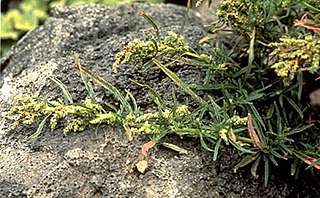
Amaranthus brownii was an annual herb in the family Amaranthaceae. The plant was found only on the small island of Nihoa in the Northwestern Hawaiian Islands, growing on rocky outcrops at altitudes of 120–215 m (394–705 ft). It was one of nine species of Amaranthus in the Hawaiian Islands, as well as the only endemic Hawaiian species of the genus. It is now considered extinct.
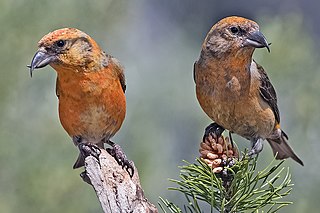
The cardueline finches are a subfamily, Carduelinae, one of three subfamilies of the finch family Fringillidae, the others being the Fringillinae and the Euphoniinae. The Hawaiian honeycreepers are now included in this subfamily. Except for the Hawaiian honeycreepers which underwent adaptive radiation in Hawaii and have evolved a broad range of diets, cardueline finches are specialised seed eaters, and unlike most passerine birds, they feed their young mostly on seeds, which are regurgitated. Besides this, they differ from the other finches in some minor details of their skull. They are adept at opening seeds and clinging to stems, unlike other granivorous birds, such as sparrows and buntings, which feed mostly on fallen seeds. Some members of this subfamily are further specialised to feed on a particular type of seed, such as cones in the case of crossbills. Carduelines forage in flocks throughout the year, rather than keeping territories, and males defend their females rather than a territory or nest.

The TanagerExpedition was a series of five biological surveys of the Northwestern Hawaiian Islands conducted in partnership between the Bureau of Biological Survey and the Bishop Museum, with the assistance of the United States Navy. Four expeditions occurred from April to August 1923, and a fifth in July 1924. Led by Lieutenant Commander Samuel Wilder King on the minesweeper USS Tanager (AM-5), and Alexander Wetmore directing the team of scientists, the expedition studied the plant animal life, and geology of the central Pacific islands. Noted members of the team include archaeologist Kenneth Emory and herpetologist Chapman Grant.

The Laysan noctuid moth is a species of moth in the family Noctuidae.

The Laysan honeycreeper or Laysan ʻapapane is an extinct bird species that was endemic to the island of Laysan in the Northwestern Hawaiian Islands.

Eragrostis variabilis is a species of grass known by the common names variable lovegrass, kawelu, emoloa, and kalamalo. It is endemic to Hawaii, where it occurs on all the main islands plus Kure Atoll, Midway Atoll, Pearl and Hermes Atoll, Lisianski Island, Laysan, and Nihoa.

The Northwestern Hawaii scrub is a tropical and subtropical grasslands, savannas, and shrublands ecoregion on the Northwestern Hawaiian Islands in the Pacific Ocean.






















